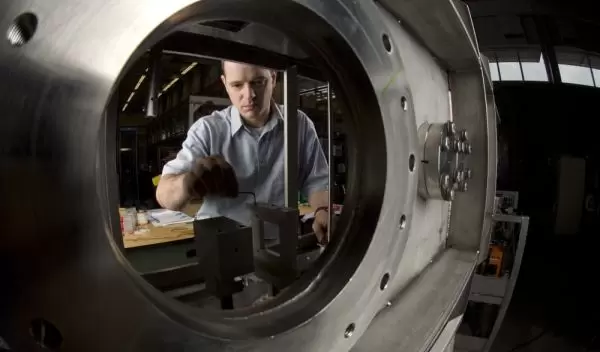
Unlocking the Secrets of Atomic Nuclei
Students at Michigan State University occasionally glance up at the mysterious word that is situated above the front door entrance of a large research facility on campus. Some continue on their way to class, not giving the word "cyclotron" another look, while others stop for a moment and ponder what takes place beyond those glass doors.
The man behind the glass doors, orchestrating the pioneering research and exciting discoveries at the NSF-supported National Superconducting Cyclotron Laboratory (NSCL) at Michigan State University is Konrad Gelbke. The director of the lab since 1994, Gelbke has been instrumental in guiding NSCL to its position as one of the foremost accelerator facilities in the nation.
On first impression, Gelbke's professionalism and focus are apparent, but he also abounds with youthful enthusiasm as he talks about the mysteries that are decoded within the facility and the important applications that have resulted from basic nuclear research, such as medical treatments and security technology.
High-speed collisions
Two cyclotrons, a type of charged particle accelerator, work in tandem at NSCL to unlock the mysteries of atomic nuclei. Accelerating atoms, then smashing them and ciphering through the spray of particles that results, can reveal the cosmic origins of elements in the universe and is even leading to promising new treatments for cancer.
Atomic nuclei are incredibly dense. Paradoxically, they account for nearly all the mass but can be as little as one ten-thousandth of the diameter of an atom. To get at the heart of the atom and unravel the mysteries surrounding it, researchers must essentially break the atom into pieces through a high-energy, high-speed collision.
Accelerated to half the speed of light and stripped of most of its electrons within the two cyclotrons, highly charged ions (atoms with a large positive electric charge) are guided and manipulated towards their final destination--a piece of beryllium metal called the production target that looks like a thick piece of aluminum foil.
Unstable elements reveal secrets
It takes less than ten-thousandths of a second for the beam of ions to leave the cyclotrons and smash into the target. Gelbke likens the process to a ray of light moving through a prism and separating into different wavelengths to produce a rainbow. Yet in this case, ions pass through the target and separate into a whole spray of particles: protons, neutrons and the rarest of isotopes.
After impact, magnetic lenses and prisms are used to sort out the variety of particles in a millionth of a second. The isotopes produced are rare, variations that are uncommon in our solar system. Extremely short-lived, such isotopes that take on or lose extra neutrons or protons as a result of the collisions do not exist on Earth. However, they are key in understanding how elements formed in the universe and close to home, how elements shaped this planet.
"Studying unstable elements can tell us what was going on inside stars, like how nuclei are made and where the elements on Earth come from," explained Gelbke. "The Earth and life are star dust, the remnant material of what happened in star explosions, so nuclear physics is a very significant part of solving the origin question."
Nuclear physics and cancer
Discoveries made inside NSCL not only probe the origins of elements and creation of planets, they also lead to breakthroughs in medical treatment. Basic scientific research in nuclear physics eventually led to proton therapy, a cutting-edge cancer treatment that delivers a concentrated pencil-line of accelerated protons directly to a tumor. Unlike neutron therapy, protons are easier to guide because of their electrical charge, and unlike x-rays, proton radiation stops at the cancerous tumor. This means less harmful impacts upon healthy cells.
NSCL worked with a supplier of scientific research instruments and proton therapy machines on technical designs for a proton accelerator, a system that is now marketed around the world.
Along with medical treatments, nuclear physics research is advancing material science with satellites that can resist radiation disruptions, improving magnetic resonance imagery (MRI) and increasing sophistication of airport security tools to detect explosives.
Cyclotron history
The first cyclotron at Michigan State University was built in the 1960s. Through the decades, the technology behind nuclear physics at the university has greatly improved and generated pioneering research.
In the early 1990s, NSCL was looking to take the next step in nuclear physics by upgrading the laboratory to compete with others in the international community. Having trouble finding funding for a new large project, Gelbke and colleagues coupled the two older cyclotrons that had been built a decade earlier into a single modern machine, defraying costs while generating world-leading capability in charged particle acceleration.
NSCL is now the largest campus-based nuclear physics lab in the country, and trains 10 percent of the country's nuclear science Ph.D.'s. However, the cyclotrons that have placed NSCL at the forefront of rare isotope research are becoming outdated.
"For us to stay relevant, we need new research tools," said Gelbke. "It's like entering into a world-champion car race today with a refurbished, vintage 1988 automobile."
For a rare isotope lab, its performance is dependent on how many isotopes it can produce, which is dependent on how many particles it can smash per second. The performance of technology can be the difference in running one test per year to discover rare particles or one test per day.
The cyclotron laboratory is in the running for a next generation nuclear research tool, one that Gelbke believes will ignite the passion of young people and produce leaders for the next generation in these fields.
-- Matthew Cimitile, Michigan State University cimitile@msu.edu
This Behind the Scenes article was provided to LiveScience in partnership with the National Science Foundation.


